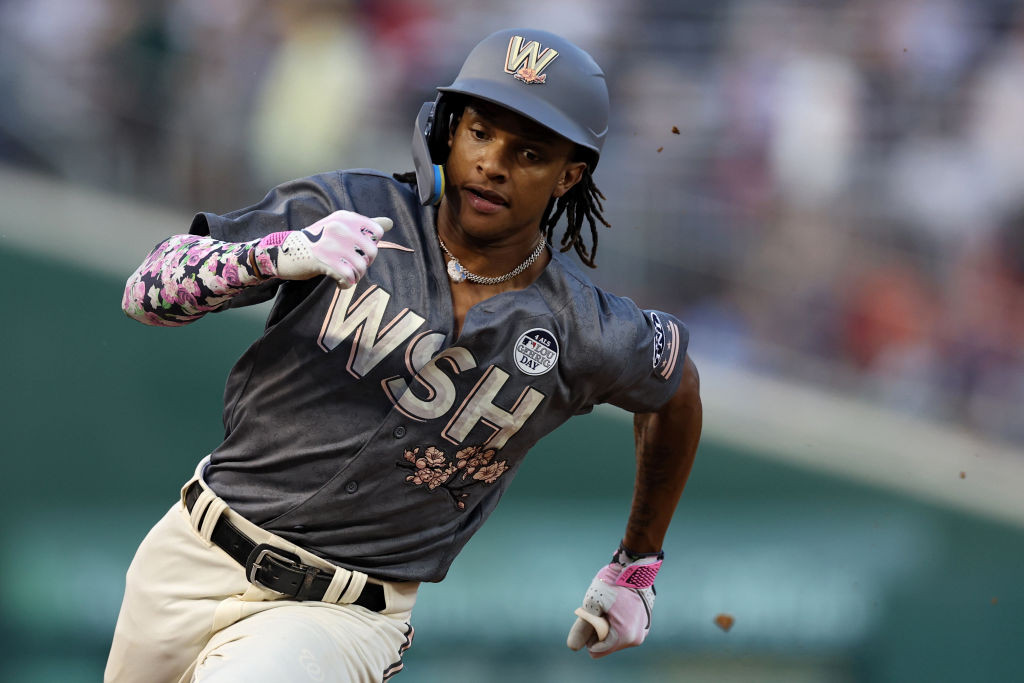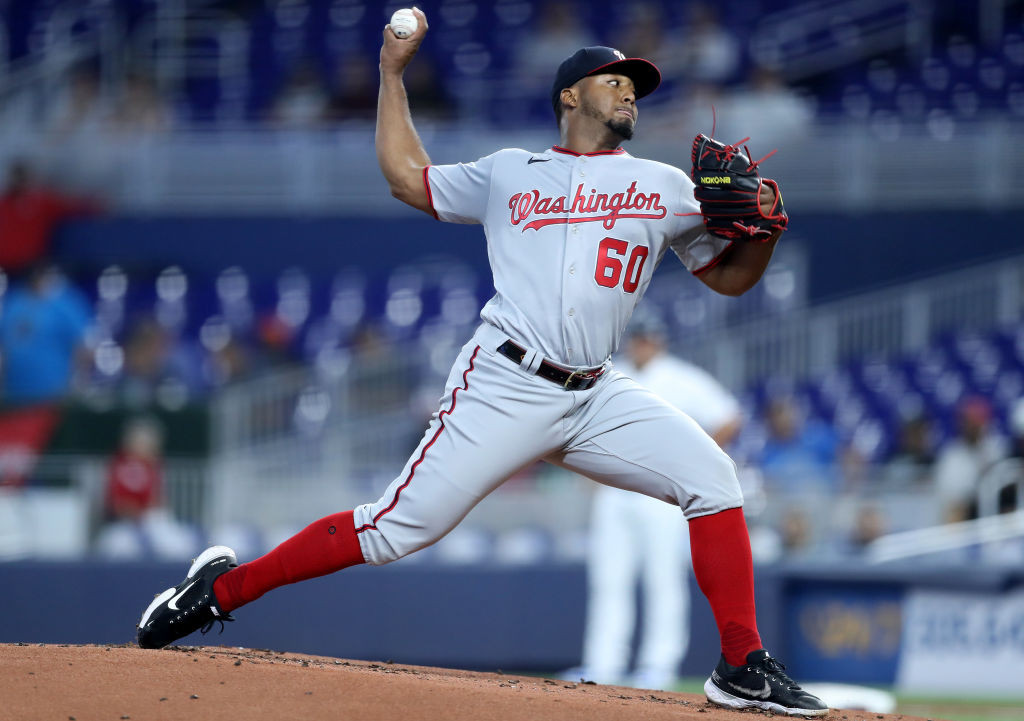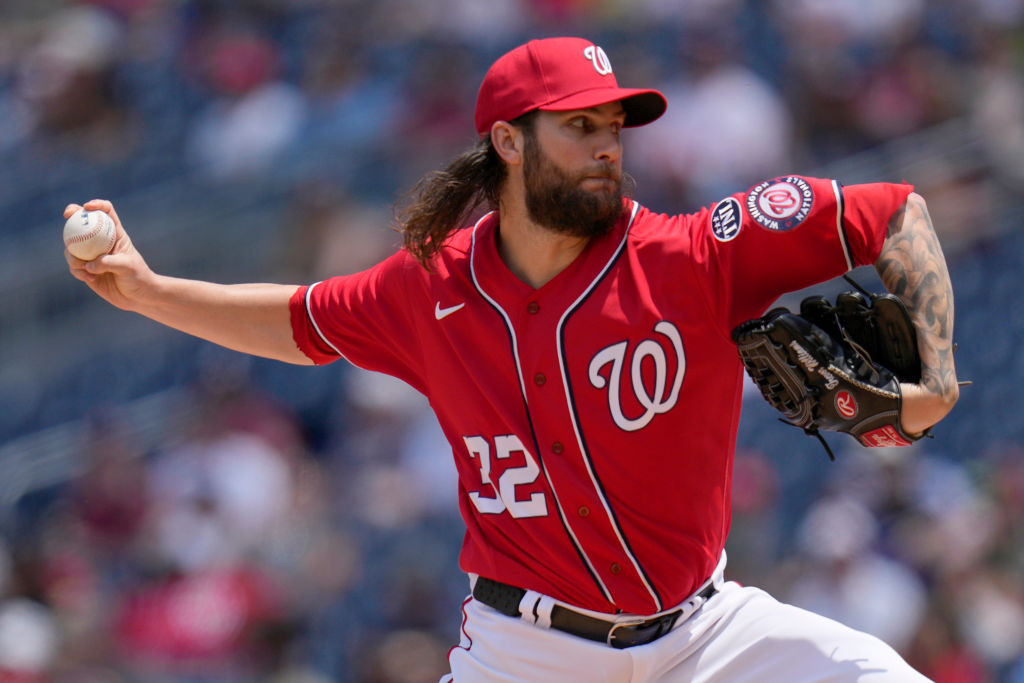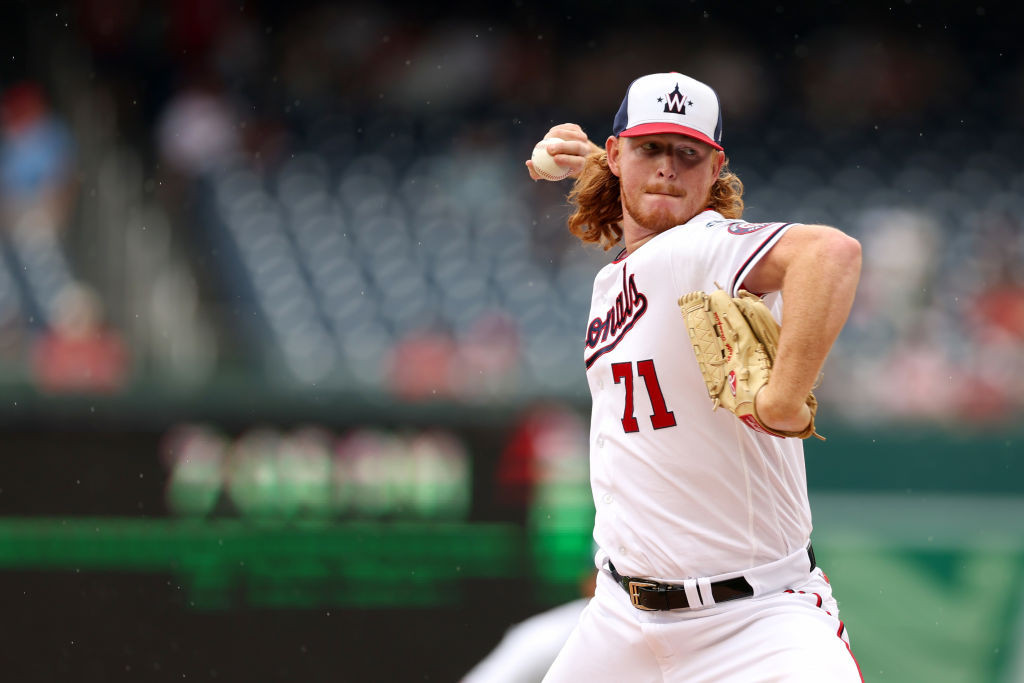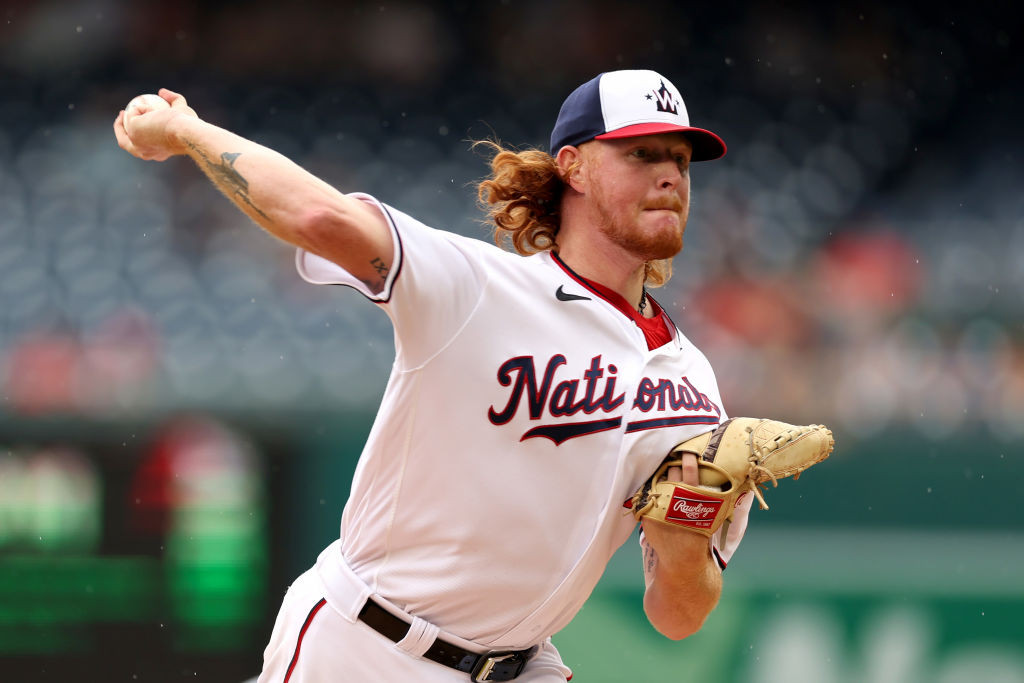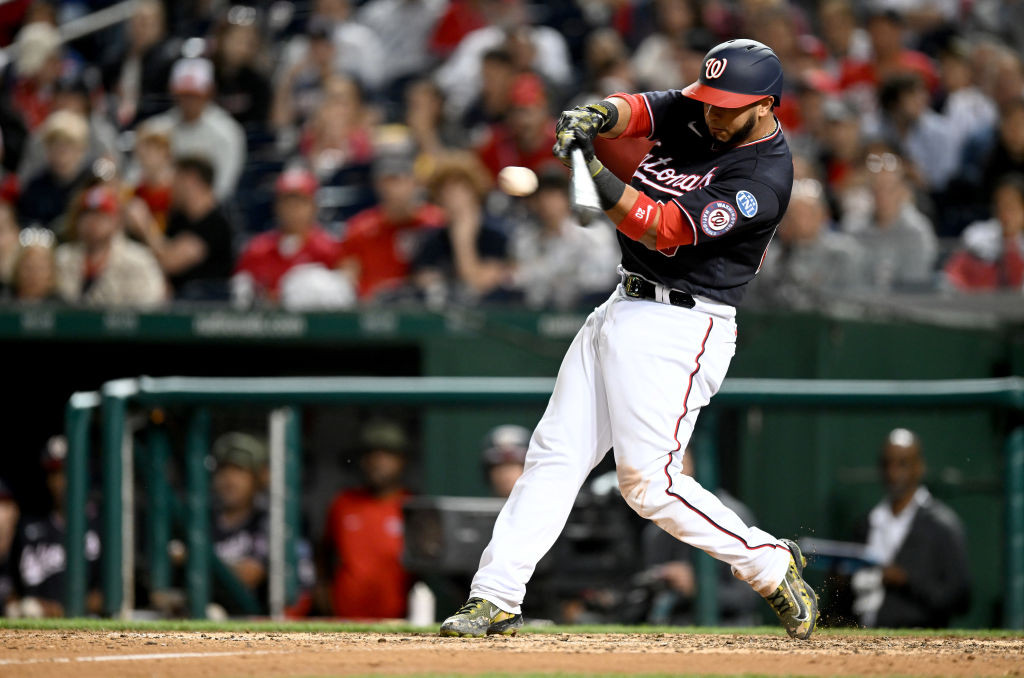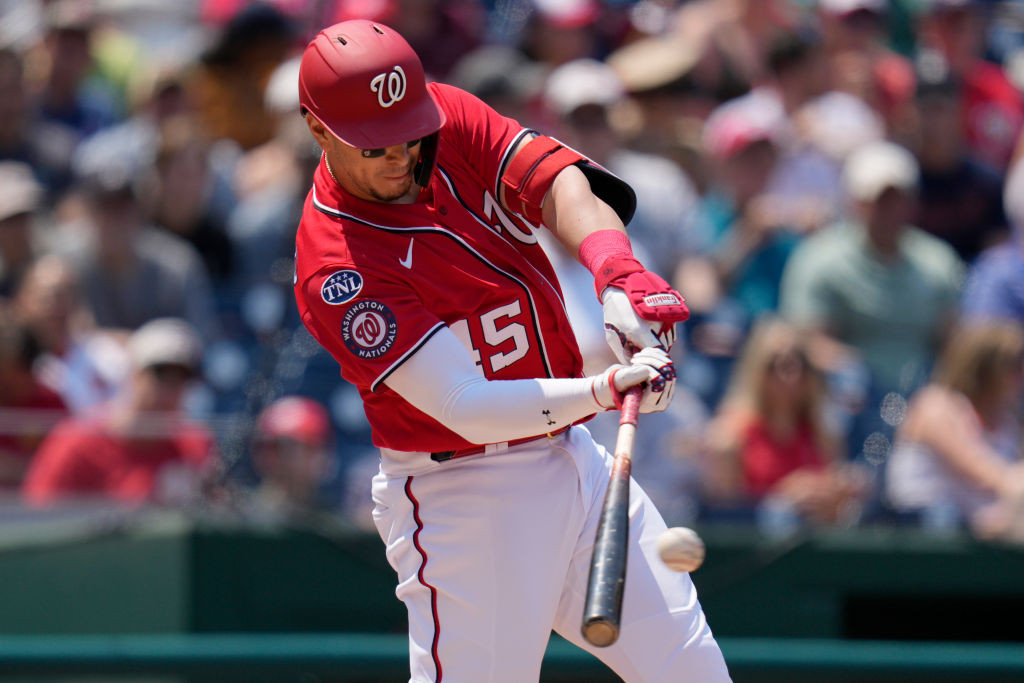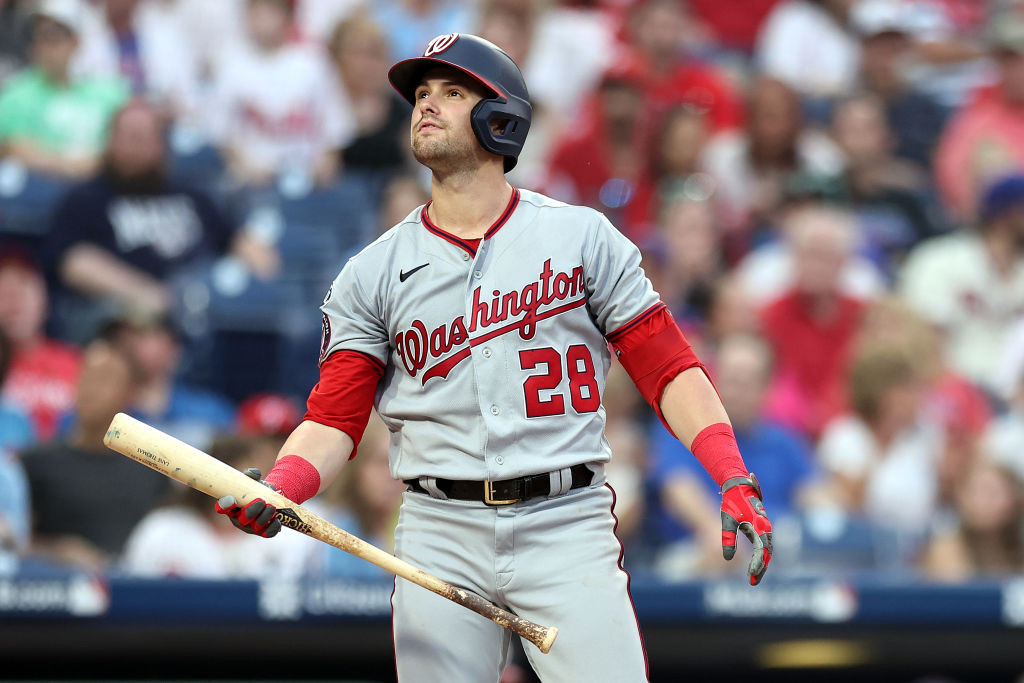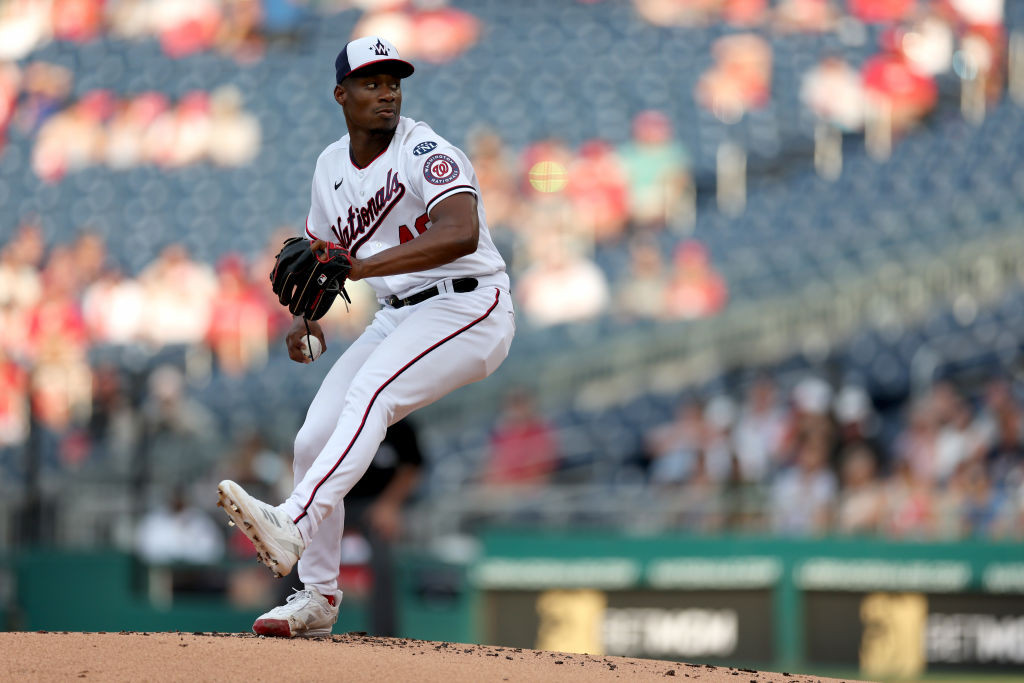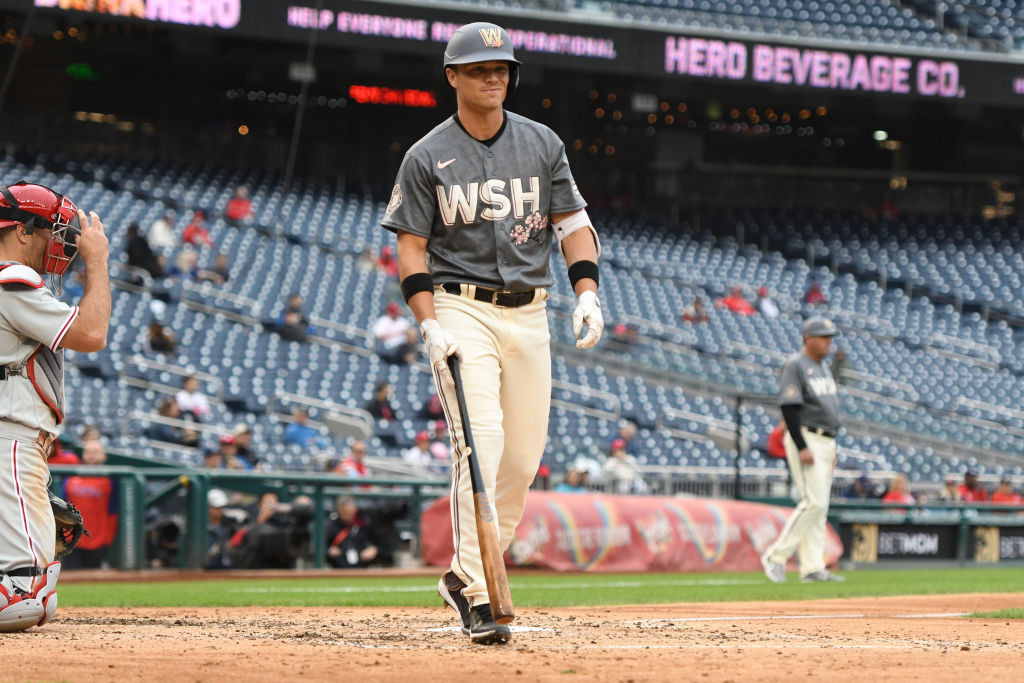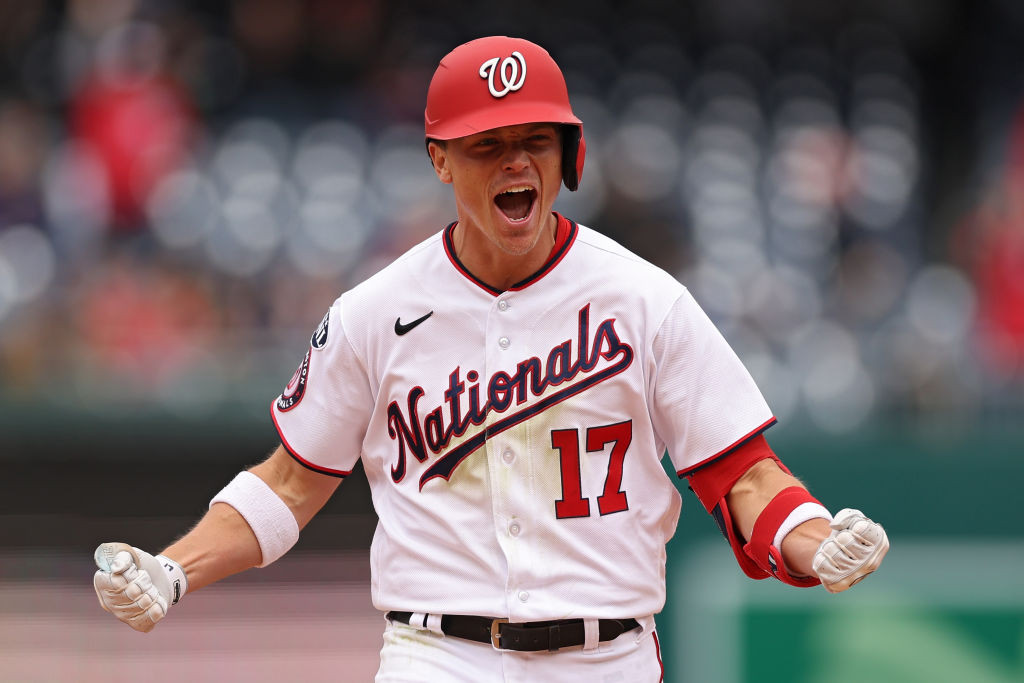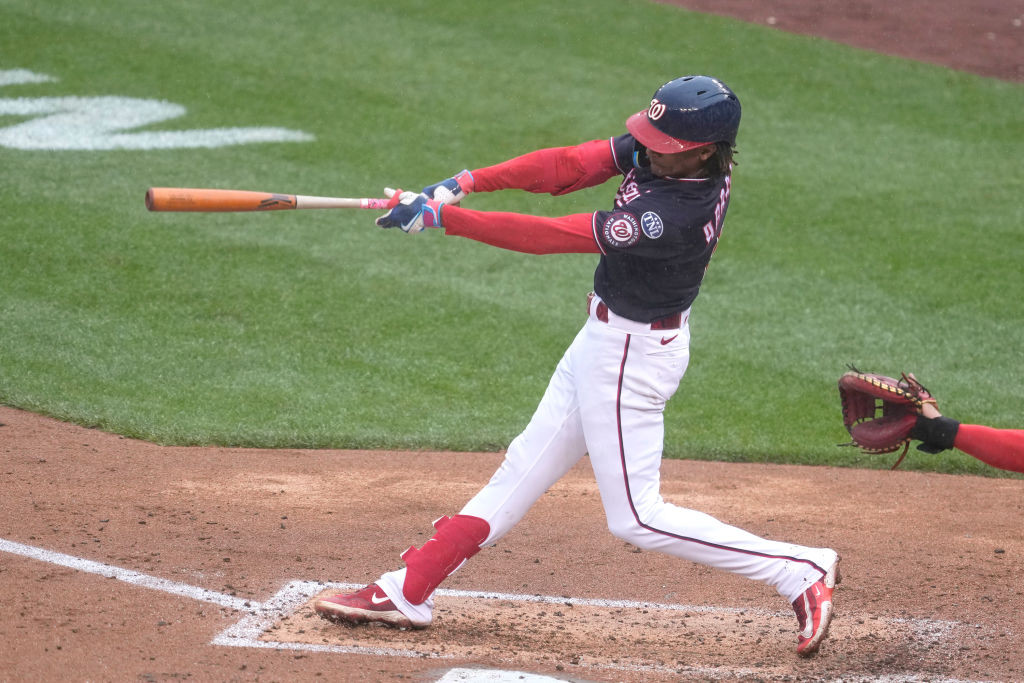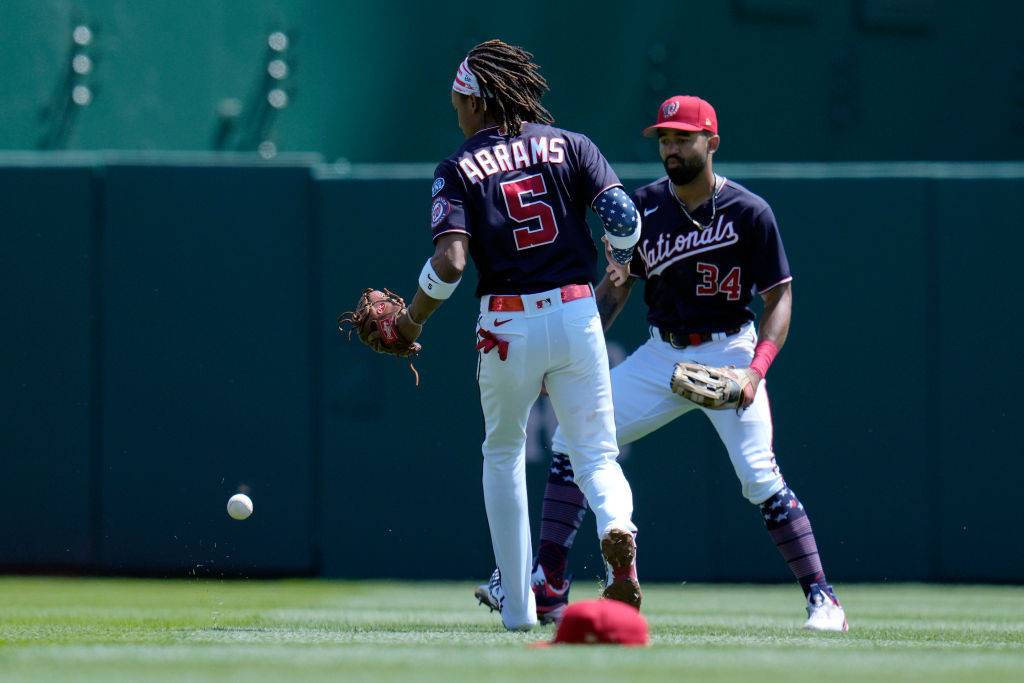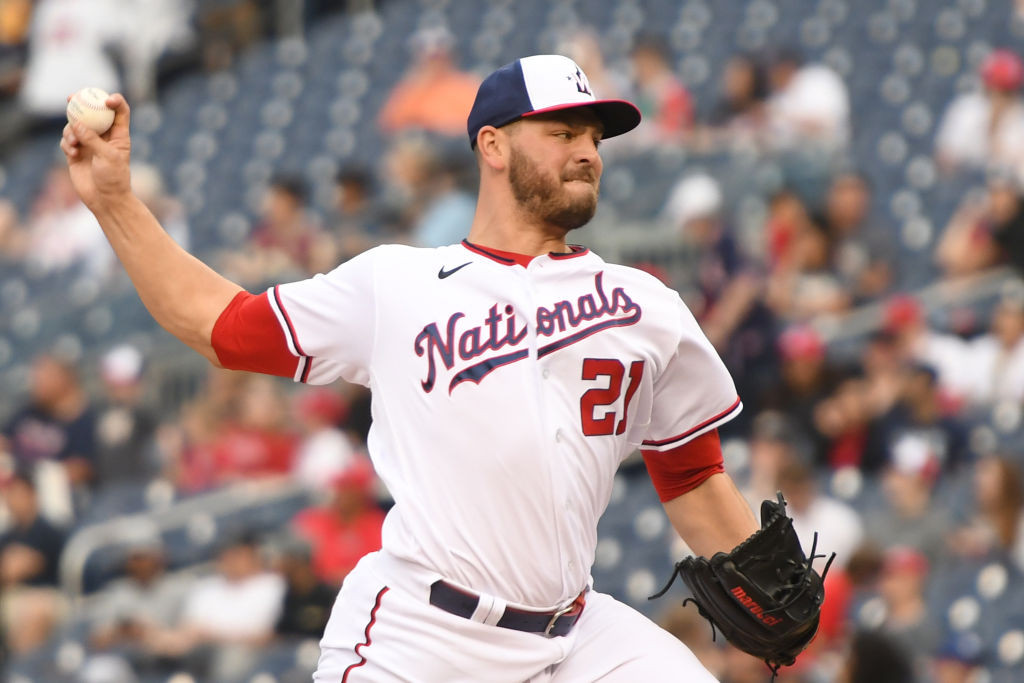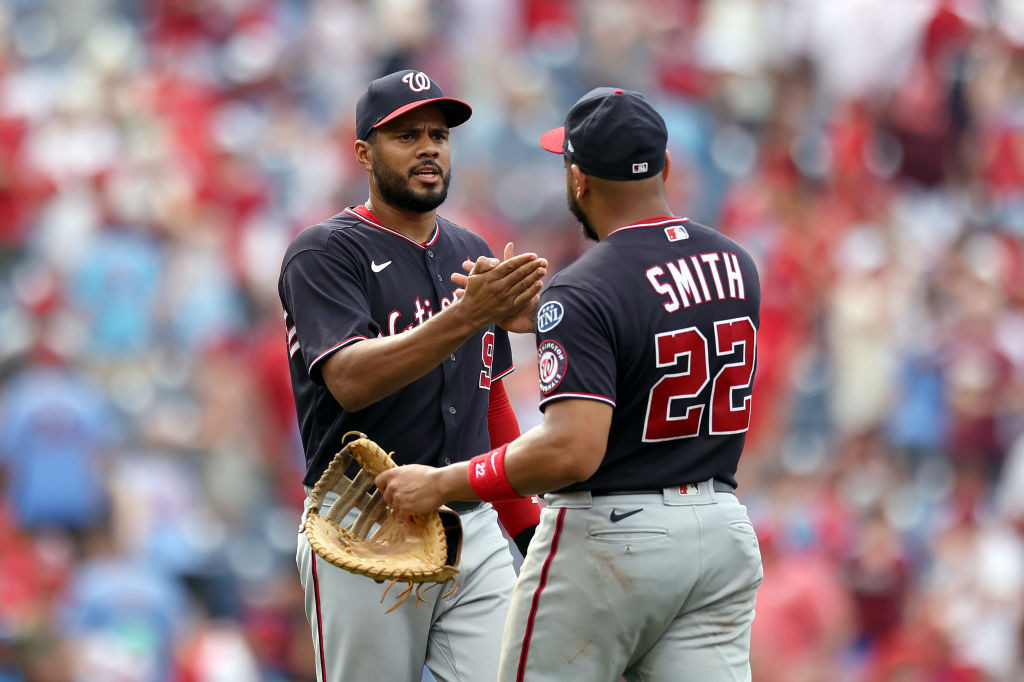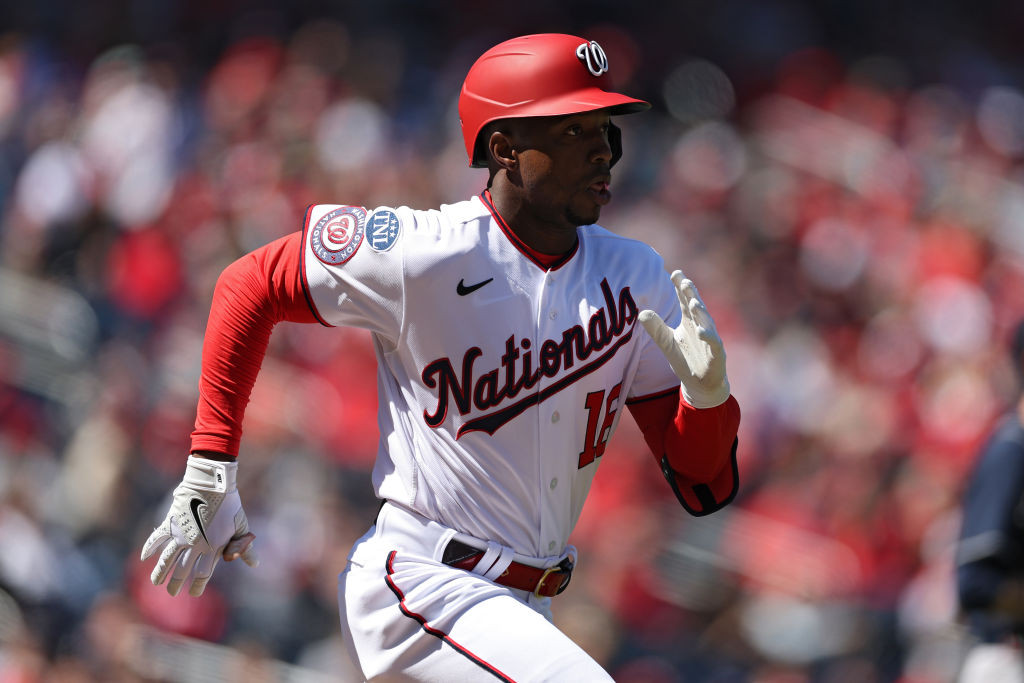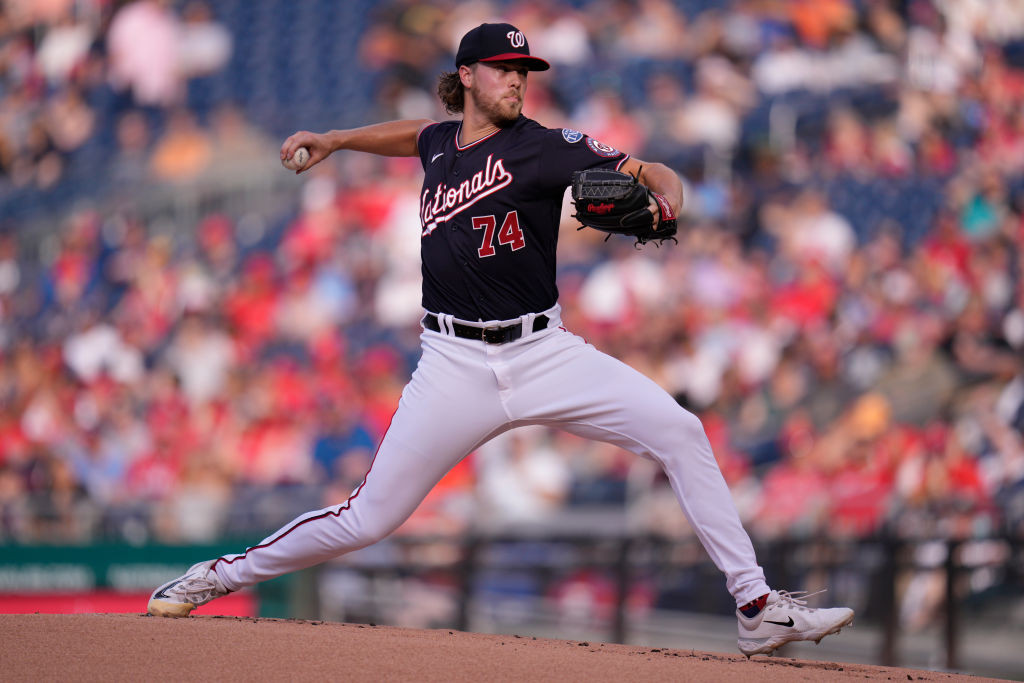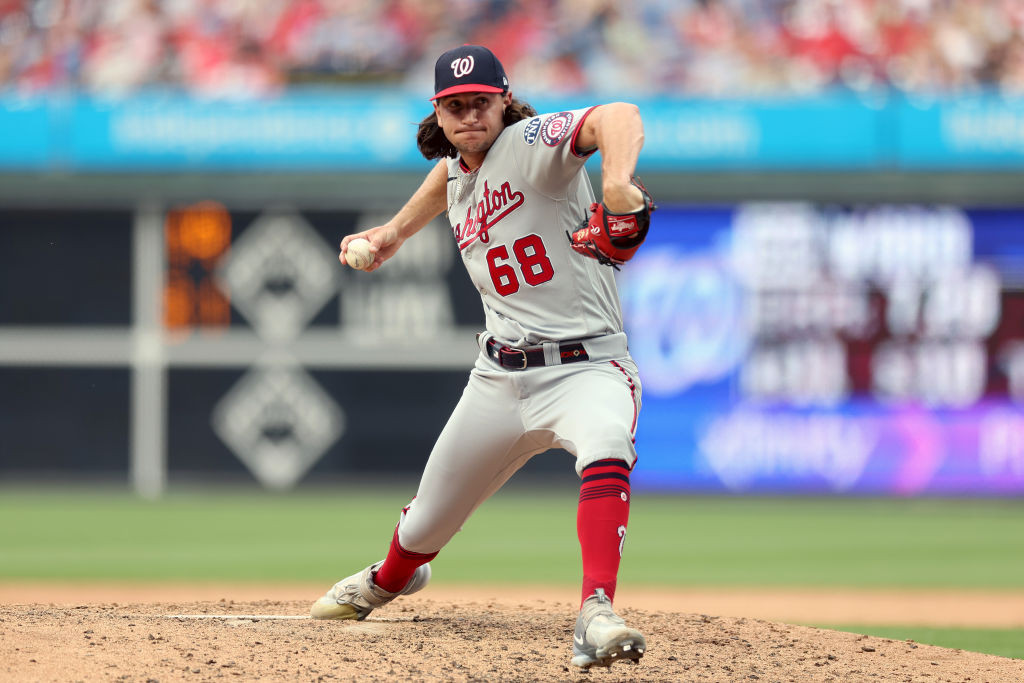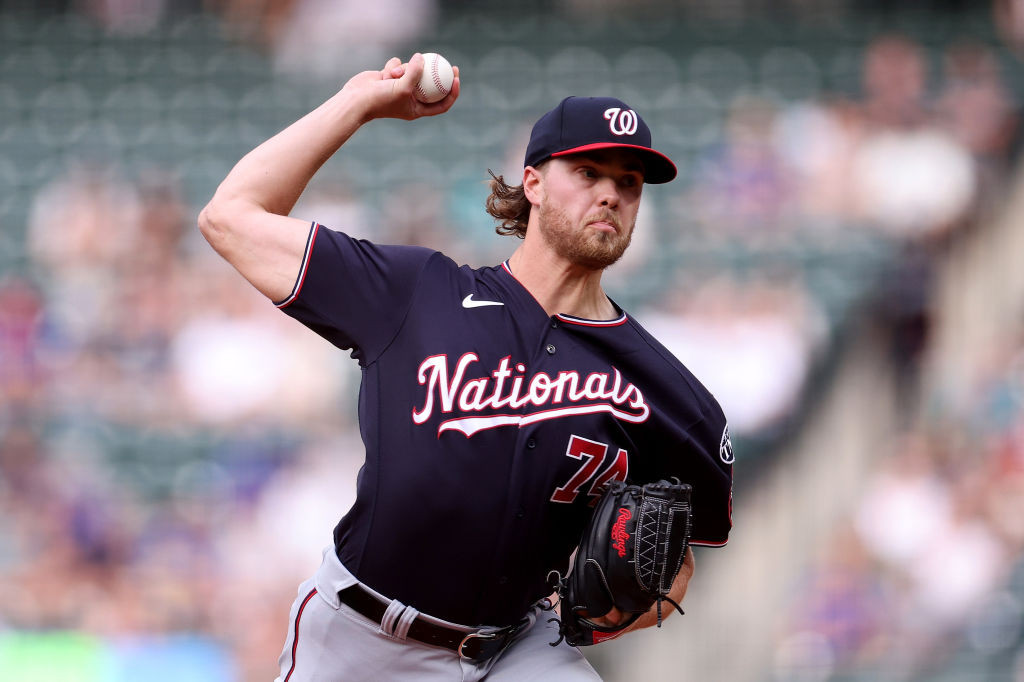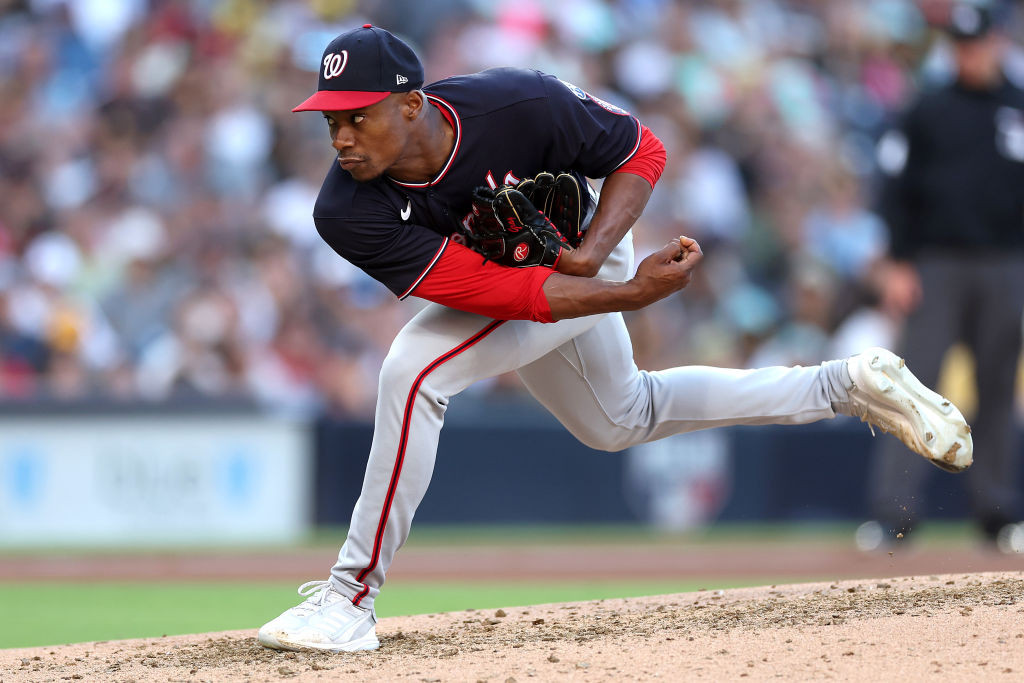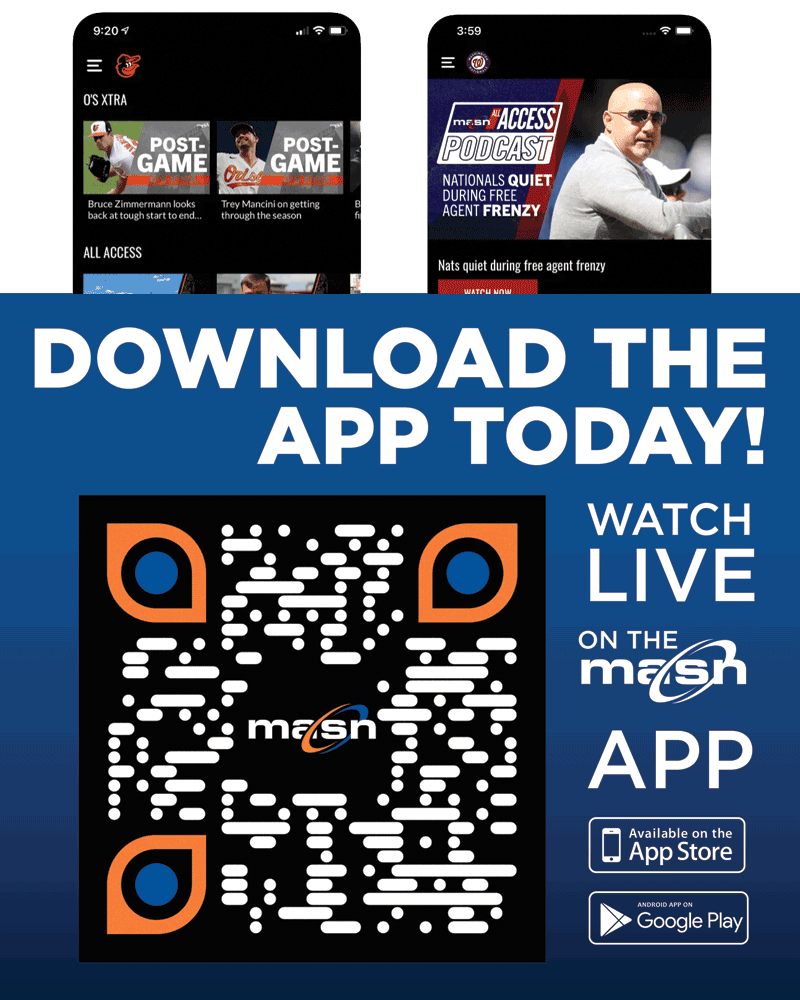On the night they lost for the 15th time in their last 16 home games – a stretch of futility that is increasingly hard to fathom – the Nationals saw Trevor Williams give up two runs early and two runs late. They saw Joan Adon make his 2023 major league debut and give up home runs to two of the first three batters he faced. They saw Joey Meneses finally end his power slump with a pair of solo homers.
All of those developments were notable within the context of this particular game, a 7-2 loss to the Rangers. None was necessarily earth-shattering in the larger scheme of things.
In this rebuilding season, the focus has been and will continue to be on the handful of young players who could be building blocks for the future. And CJ Abrams has always been near the top of the list of players who fit that description.
So the most significant thing that happened tonight may not have been the end result, but the name of the player Davey Martinez wrote down in the No. 1 position on his lineup card.
"He's had almost 300 plate appearances now, so I think it's time," the manager said. "I think it's time we push him up, see what he can do. He's got all the ability to be a really good leadoff hitter. Now he's just got to understand what he needs to do every day to do that: That's to be consistent, not chase and try to get on base. Not try to do too much."
A Nationals pitching staff that was overtaxed the last few days will have a fresh arm for the final series of the first half: Joan Adon.
Adon was recalled from Triple-A this afternoon, giving the Nats someone who could churn out a good number of innings if needed out of the bullpen against the Rangers. Left-hander Joe La Sorsa was optioned to Rochester to clear a roster spot.
The events of the last two days made some kind of move inevitable. La Sorsa threw 51 pitches in two innings of relief Wednesday night, making him unavailable to return until at least Saturday. Jordan Weems threw 27 pitches that night, then returned to throw 28 on Thursday, likely knocking him out a few days as well.
The 1-hour, 43-minute rain delay in the second inning Thursday really threw a wrench into plans, with starter MacKenzie Gore unable to continue after throwing only 17 pitches. Manager Davey Martinez wound up using six relievers to cover the remaining 8 2/3 innings necessary in a 10-inning loss to Cincinnati.
Hence the decision to promote Adon, who was scheduled to start for Rochester on Thursday night but was instead informed he was to report to D.C. The 24-year-old right-hander has made 15 starts at Triple-A this season, going 2-5 with a 4.81 ERA and 1.578 WHIP.
The Nationals had no luck against the Reds this week, dropping four straight to the surprise leaders of the National League Central. Will they fare any better this weekend against the Rangers, the surprise leaders of the American League West?
Texas has enjoyed its resurgence not as much through a rebuilding farm system like Cincinnati, but through a spending spree in recent years that included Marcus Semien, Corey Seager, Nathan Eovaldi and Jacob deGrom. That last addition hasn’t worked out, but the others have done well, especially Seager, owner of a 1.040 OPS. Having said that, the Rangers enter this series on a bit of a downswing, having dropped nine of their last 13 games.
The Nationals need to play better all around this weekend. It begins tonight with Trevor Williams, who continues to give his team a chance, even if the right-hander doesn’t exactly dominate on the mound. Williams probably needs to provide some length tonight, given the fact Davey Martinez had to burn up his whole bullpen after Thursday’s second-inning rain delay.
The lineup gets another crack at an opposing left-hander, in this case, Cody Bradford. The 25-year-old makes only his seventh career appearance tonight, having tossed 2 1/3 scoreless innings of relief four days ago against the Astros. Davey Martinez will not have Jeimer Candelario, who sits after getting hit by a pitch on his right knee Thursday. He will, however, have CJ Abrams batting leadoff for the first time this season, with Lane Thomas second. More on that notable change to come ...
WASHINGTON NATIONALS vs. TEXAS RANGERS
Where: Nationals Park
Gametime: 7:05 p.m. EDT
TV: MASN, MLB.tv
Radio: 106.7 FM, MLB.com
Weather: Chance of storms, 83 degrees, wind 5 mph left field to right field
There was a certain admirable quality to what the Nationals bullpen did Thursday afternoon. After a 1-hour, 43-minute rain delay forced MacKenzie Gore’s start to end after only 1 1/3 innings and 17 pitches, Davey Martinez had to ask six relievers to churn out a combined 8 2/3 innings in a game that wasn’t decided until the 10th.
Of course, the bullpen’s performance would’ve been appreciated even more had Kyle Finnegan not surrendered the game-tying run in the eighth and Hunter Harvey surrendered the game-winning runs in the 10th.
But given the circumstances, and what was asked of them, Martinez couldn’t get too down on the group as a whole.
The key figure in the proceedings was Mason Thompson, who was summoned to take over when the rain delay ended, thrust into a jam in the top of the second. The right-hander proceeded to induce an inning-ending, 6-2-3 double play, then returned to pitch the third and fourth innings, ultimately allowing one run to the Reds.
“It starts with the first guy and wondering how far he can go,” Martinez said. “Mason did a great job. You’re hoping for an inning and two-thirds, and he gave us more than that. So that set the tone. Then the rest of the guys just followed suit. I thought they did really well.”
As soon as the skies opened in the top of the second at Nationals Park, this was guaranteed to be an unconventional day at the yard.
The grounds crew would need to put in extra work to get the field playable once the storm passed. Bullpens would need to be asked to work overtime, with starters burned up. Benches would be emptied, players would switch positions, designated hitters would be forfeited.
In the end, the path may have been different, but the result was not. The Nationals lost yet another home game, this time by a count of 5-4 in 10 innings to a Reds team that just completed a four-game sweep in impressive fashion.
Nick Senzel’s two-run homer off Hunter Harvey on the first pitch of the 10th was the deciding blow, though it was Senzel’s defensive efforts in the bottom of the ninth that made it possible in the first place.
With a chance to win it in regulation, the Nats got a one-out double from Riley Adams and then thought for a moment they got at least a walk-off double (if not a homer) from CJ Abrams. But Senzel’s leaping catch at the wall in right denied the home team a chance for a rare celebration, and ultimately sent the game into extras.
Joey Meneses had a little extra bounce in his step this morning, certainly more than you’d expect from a player facing the quick turnaround from a three-hour game the previous night to a 1:05 p.m. first pitch today.
The reason for Meneses’ good mood: He’s playing first base for the Nationals in today’s series finale against the Reds.
This has become a rare event. Meneses, who has served as the Nats’ designated hitter 74 times in the team’s first 86 games, is playing only his sixth game in the field this afternoon. It’s the first time he’s played first base since April at Citi Field in New York.
“He’s excited about it,” manager Davey Martinez said. “He takes ground balls every day. He gets a chance to go out there today and play the field. He’s up for it.”
With left-hander Brandon Williamson starting for the Reds, Martinez decided to give both Dominic Smith and Luis García the day off and go with a more right-handed-heavy lineup. That includes Ildemaro Vargas at second base and Keibert Ruiz as DH.
The Nationals, plain and simple, have not played good baseball this week. It’s not just the fact they’ve lost three straight to the Reds, it’s the way they’ve looked in losing those three games. Sloppy defense. Bad pitching. An inability to deliver at the plate with runners in scoring position. It’s been ugly.
One win in today’s series finale won’t change all that, but it sure wouldn’t hurt. Success would start with MacKenzie Gore, who needs a bounceback performance of his own after giving up seven runs in only 2 2/3 innings his last outing at Philadelphia. The lefty would love to go into the All-Star break on a better note, not to mention an ERA lower than the 4.48 mark he brings into today’s start.
The Nats face another unfamiliar pitcher today in Cincinnati’s Brandon Williamson, who makes his 10th career start. The 25-year-old left-hander enters with a 5.56 ERA, but he did hold the Padres to two runs over five innings in his last appearance.
WASHINGTON NATIONALS vs. CINCINNATI REDS
Where: Nationals Park
Gametime: 1:05 p.m. EDT
TV: MASN2, MLB.tv
Radio: 106.7 FM, MLB.com
Weather: Chance of storms, 89 degrees, wind 6 mph right field to left field
NATIONALS
RF Lane Thomas
3B Jeimer Candelario
1B Joey Meneses
LF Stone Garrett
DH Keibert Ruiz
2B Ildemaro Vargas
C Riley Adams
SS CJ Abrams
CF Alex Call
For all the trouble they had when the Reds were at bat Wednesday night, the Nationals might actually have given themselves a chance to win the game had they simply converted some golden scoring opportunities in their first two innings at the plate.
Instead, another failure to pounce on a struggling opposing starter set the tone for what became a 9-2 rout rather than a competitive ballgame.
Seven of the Nationals’ first nine batters actually reached base against Cincinnati starter Graham Ashcraft, who entered with a 6.66 ERA. Only one of those seven (Lane Thomas) would score, and he only did so via wild pitch.
Thomas opened the bottom of the first with a walk, the 30th time he has reached base in the 61 games he has led off the first inning. Luis Garcia followed with a single, but Jeimer Candelario grounded into a killer double play that moved Thomas to third but left the Nats with two outs. Even so, they still proceeded to load the bases when Joey Meneses walked and Dominic Smith was hit by a pitch.
Ashcraft’s wild pitch scored Thomas and moved everybody else up one base, but Keibert Ruiz then grounded out to end that rally with only the one run across the plate.
Whether it was a display of gamesmanship meant to rattle a talented rookie or genuine concern about the device Elly De La Cruz had wrapped around the knob of his bat, Davey Martinez and the Nationals’ actions in the top of the second this evening didn’t produce anything close to a desired result for the home team.
Not only was De La Cruz ultimately allowed to use the device, he used it while launching a gargantuan home run to right-center and then immediately pointed at it before circling the bases, the defining moment of the Nats’ ugly, 9-2 loss to the Reds on a long, muggy night of unsightly baseball on South Capitol Street.
De La Cruz, the sport’s top-rated prospect one month ago and now the face of Cincinnati’s sudden resurgence to the top of the National League Central division, had his way with the Nationals for the second straight day.
The Nats? They lost their third straight to open this four-game series, not to mention their 13th loss in their last 14 home games despite having gone 6-3 on the road in between all that.
"We can't give teams those extra outs," Martinez said after watching his team commit two errors and allow four stolen bases. "Every time we do that, it comes back and bites us."
The Nationals’ continued search for a productive center fielder while Victor Robles is on the injured list landed on a familiar face today: The club recalled Alex Call from Triple-A Rochester and designated struggling Derek Hill for assignment.
Call rejoins the Nats only three weeks after he was demoted because of his own struggles, plus Robles’ initial return from a back injury. When Robles had to go back on the 10-day IL with a recurrence of the injury, Hill was given the promotion over Call.
Hill never found offensive success in D.C. Though he had a robust .914 OPS at Triple-A, the 27-year-old outfielder batted just .170 with one extra-base hit, three walks, 11 strikeouts and a .411 OPS in 13 big league games. He finally recorded his first RBI in his 48th plate appearance during Tuesday’s 8-4 loss to the Reds.
“When you’re not seeing the results, you start pressing a little bit,” manager Davey Martinez said. “We talked to him about shortening his swing a little bit, and it felt like he was getting long. We worked with him, and just nothing came out of it.”
Having already played for the Tigers in parts of the previous three seasons, Hill was out of options and couldn’t be demoted without first being exposed to waivers. Hence today’s move to designate him for assignment. If he goes unclaimed, he could wind up back in Rochester.
The Nationals tonight look to bounce back from two uninspired losses to the Reds to begin this homestand, and they’ll have a new face patrolling center field. (Though he’s not actually new, he’s just back for the first time in a few weeks.) Alex Call has been recalled from Triple-A Rochester, with struggling Derek Hill designated for assignment after a particularly rough game Tuesday.
Call, who didn’t exactly set the world on fire at the plate while filling in for the injured Victor Robles, gets another chance to prove his worth until Robles is ready to return from his lingering back issues. He’ll bat ninth tonight, behind CJ Abrams. Joey Meneses returns to the cleanup spot, with Dominic Smith bumped down to the No. 5 position against Reds right-hander Graham Ashcraft.
Josiah Gray makes his final start before heading to Seattle for his first All-Star Game. The young right-hander is coming off one of his best outings of the season in Philadelphia, and surely he would love to keep the positive vibes going before he joins his fellow All-Stars out West next week.
WASHINGTON NATIONALS vs. CINCINNATI REDS
Where: Nationals Park
Gametime: 7:05 p.m. EDT
TV: MASN2, MLB.tv
Radio: 106.7 FM, MLB.com
Weather: Partly cloudy, 89 degrees, wind 4 mph right field to left field
NATIONALS
RF Lane Thomas
2B Luis García
3B Jeimer Candelario
DH Joey Meneses
1B Dominic Smith
C Keibert Ruiz
LF Corey Dickerson
SS CJ Abrams
CF Alex Call
CJ Abrams came up to bat four times during Tuesday’s game at Nationals Park, and he was legitimately pleased with both the process and the results of three of those plate appearances.
There was a third-inning double to right. There was a fifth-inning double to left. And there was a ninth-inning leadoff walk.
The common theme with those plate appearances? Abrams swung at pitches in the zone and took those outside the zone. He took two pitches off the plate and then doubled on a changeup right over the heart of the zone in the third. He took three straight pitches, two of them called balls, before driving a sinker at the knees the other way for a double in the fifth. And he took five straight pitches in the ninth, the first of them called a strike, the others all called balls.
“I was swinging more at my pitch today,” he said. “Swinging at good pitches I can handle. I was seeing in the zone, going fastball the other way, pulling the changeup and reacting.”
The ninth-inning walk, in particular, pleased Abrams’ manager.
The home runs surrendered – all three of them – were bad. They accounted for five of the eight runs the Nationals allowed today during an 8-4 loss to the Reds.
If you’ve paid any attention to this team this year (or recent years, for that matter), you know that matters less to Davey Martinez than the quality of baseball his team plays. Which is why this Independence Day performance, in which the home club made just about every manner of fundamental mistake possible in the sport of baseball, was far more alarming than the glare of the bombs bursting in air rocketed off the Reds’ bats.
There were extra bases taken by Cincinnati and extra bases handed over by Washington. There was a successful pickoff attempt that turned into one of six Reds stolen bases after Dominic Smith's throw tailed past Luis García's reach. There was a popup into shallow left-center that fell in between three fielders. There was an uncontested steal of third that put the runner in position to score moments later on a sacrifice fly, then another uncontested steal of third the following inning that mercifully didn't cost them in the end.
"We've got to play better," Martinez said. "We came off a (6-3) road trip that we played really, really well. We've got to get better. ... Today, the defense wasn't there. We couldn't hold their runners on. They were stealing everywhere. We've got to get better holding runners on. We can't let them just get out there and run."
All of that made for a frustrating game to watch for a Fourth of July crowd of 30,434 that desperately wanted to see better play from the home club, but instead could only watch the young and aggressive Reds win for the 18th time in their last 22 games and wish the Nationals played like that.
From the moment last summer he learned he would need Tommy John surgery, Tanner Rainey established his goal for recovery: Return to the Nationals in one year.
The right-hander now finds himself one month away from that target date, and though he believes he could be pitching in a major league game come early August, he understands why the Nats are purposely slowing him down a bit.
“It’s still a goal,” Rainey said. “I would like to be ready to face hitters full-on around that one-year mark. It’s not something I want to get too tied up in. I’d rather be completely healthy and ready to go than just hit a goal. But obviously that one-year mark is still on my mind.”
After spending the majority of the season rehabbing in West Palm Beach, Fla., Rainey is in Washington this week, invited back by manager Davey Martinez to throw in front of the major league coaching and training staffs and spend some quality time with teammates as he enters the final phase of his recovery process.
Rainey had his elbow ligament replaced August 3. He’s had no setbacks since then and is currently throwing two 45-pitch bullpen sessions per week. He has not faced live hitters yet, but he’s likely to cross that important threshold next week.
It’s Independence Day in the nation’s capital, and that means morning baseball. It’s become a great tradition here, the 11:05 a.m. first pitch at Nationals Park. It can be a rush for everyone to get to the park and get prepared for the game, but once it starts it’s always a fun atmosphere. And everyone loves being able to head home early and enjoy the rest of the holiday.
The Nationals will be hoping for more fireworks at the plate than they produced during Monday night’s 3-2 loss. They’re going to have to be better with runners in scoring position (1-for-9). If not, they’re going to have to hit the ball out of the park with some runners on base for a change.
Patrick Corbin gets the start, and he’s coming off his best outing of the season, in which he shut out the Mariners over seven innings. The Reds have a potentially tough lineup, but we saw Jake Irvin and Co. hold them to three runs Monday night, so there is a path to success for Corbin.
WASHINGTON NATIONALS vs. CINCINNATI REDS
Where: Nationals Park
Gametime: 11:05 a.m. EDT
TV: MASN2, MLB.tv, MLB Network
Radio: 106.7 FM, MLB.com
Weather: Partly cloudy, 83 degrees, wind 8 mph left field to right field
NATIONALS
RF Lane Thomas
2B Luis García
3B Jeimer Candelario
1B Dominic Smith
DH Joey Meneses
LF Corey Dickerson
C Riley Adams
SS CJ Abrams
CF Derek Hill
Coming into the season, the Nationals believed speed would be one of the strongest assets to their young lineup.
Now officially past the halfway point of the season, it hasn’t been as effective as they might have hoped.
Did you know up until last week Victor Robles was still the team’s leader in stolen bases? The speedy outfielder has only played 36 games this season, missed 34 in May and June with a back injury and is currently on his second stint on the injured list. CJ Abrams swiped one in San Diego and one in Seattle to overtake him 79 games into the season.
Entering Sunday’s finale against the Phillies, the Nationals ranked as one of the worst teams in terms of stealing bases in the major leagues. They had only stolen 43 bases in 56 attempts, which were 25th in the majors and 13th in the National League. That equated to a 76.8 percent success rate, which ranked 22nd in the majors and 12th in the National League.
They were only stealing 0.68 bags per game, 26th in the big leagues and 13th in the NL.
Facing baseball’s hottest team, the Nationals turned to four of their least-experienced pitchers tonight, then watched as Jake Irvin, Jordan Weems, Joe La Sorsa and Amos Willingham did everything in their power to minimize damage and give their teammates a chance to beat the Reds.
Presented with that opportunity, the Nats lineup faltered, leaving the biggest crowd of the season on South Capitol Street to watch a postgame fireworks show frustrated following a 3-2 loss.
The game was there for the taking all night long, if only somebody standing at the plate in a Nationals uniform was willing to take it. Alas, they managed only hit with a man in scoring position, misfiring just about every time they had a shot at tying the game or even taking the lead.
"We were 1-for-9 with runners in scoring position. That hurt us from the first inning on," manager Davey Martinez said. "I talk about it all the time: Drive in that runner from third with less than two outs. We've got to find a way to do that. It's a different ballgame if we do that."
Returning home from a highly successful, 6-3 trip to San Diego, Seattle and Philadelphia, the Nats reverted back to the form that has plagued them all year long in this ballpark. They are now an inexplicable 13-28 at home, worst in the National League despite a very respectable 21-22 record on the road.
After spending the majority of the season to date with zero left-handers in their bullpen, the Nationals are going to keep two for the time being after making another roster move today, but not the one that seemed the likeliest.
With Patrick Corbin returning from the bereavement list, the Nats placed Thaddeus Ward on the 15-day injured list with right shoulder inflammation, keeping both Jose A. Ferrer and Joe La Sorsa in a bullpen that suddenly includes two lefties.
Ferrer just made his major league debut Saturday after his promotion from Triple-A Rochester. The 23-year-old pitched a scoreless inning against the Phillies, then did it again during Sunday’s 5-4 victory. He’ll now get a chance to stay and prove he can enjoy continued success at this level.
“He’s throwing the ball well,” manager Davey Martinez said. “The biggest thing I like is he’s throwing strikes. It’s something I talked to him about when he got here: ‘It doesn’t matter how hard you throw, or what you throw. It’s about throwing strike one.’ And so far, he’s done that.”
La Sorsa, who made two appearances for the Rays earlier this season before the Nationals claimed him off waivers and called him up late last month, impressed in his first two outings but allowed four runs while facing only five batters during Saturday’s 19-4 loss in Philadelphia.
When they left town a week and a half ago, the Nationals were reeling, having just gone 1-6 during one of the worst homestands in club history. They return tonight having completely reversed that trend, going 6-3 on a long trip that included stops in San Diego, Seattle and Philadelphia. What should we expect now as they open the final week of the first half with seven games in seven days against two of the majors’ most surprising teams?
It begins tonight with the first of four against the Reds, who only three weeks ago were 29-35 and in third place in the National League Central. Since then, with top prospect Elly De La Cruz leading the way, they’ve gone 16-4 and now are tied with the Brewers atop the division.
It’ll be up to Jake Irvin to try to hold that exciting Cincinnati lineup down. The rookie right-hander has looked quite impressive since returning from a brief hiatus to rest and work on his mechanics. He’s got a 2.70 ERA in those three starts, issuing only five walks while striking out 14. He’s still looking for his first win since May 8, though.
Veteran right-hander Luke Weaver starts for the Reds, and things have not gone well for him. Weaver enters tonight with a 6.96 ERA and 1.608 WHIP, though curiously he hasn’t received a decision either way in his last nine starts.
WASHINGTON NATIONALS vs. CINCINNATI REDS
Where: Nationals Park
Gametime: 6:05 p.m. EDT
TV: MASN2, MLB.tv
Radio: 106.7 FM, MLB.com
Weather: Thunderstorms, 84 degrees, wind 8 mph out to center field
PHILADELPHIA – Josiah Gray is an All-Star. It’s the first time the young right-hander has received the honor.
He will represent the Nationals in the 93rd Midsummer Classic next week in Seattle. Joining him from the organization will be top prospects James Wood and Brady House in the Futures Game.
It’s a significant movement as the Nats’ future will be recognized during the Festivities at T-Mobile Park.
Gray, of course, was a part of the first major trade the Nationals made in 2021 to kickstart this rebuild. Now, almost two years later, he’s a major league All-Star. It’s especially impressive when you look at the ups and downs he endured last year during his first full major league season.
The All-Star honor is very special to Gray individually. But it also means a lot to his teammates and the organization as a whole.

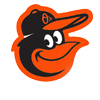
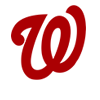

-1745819772711.png)
